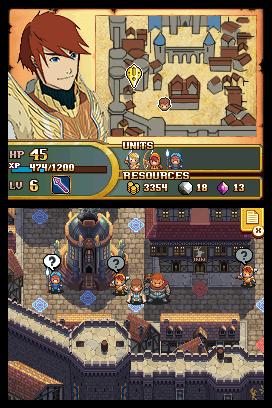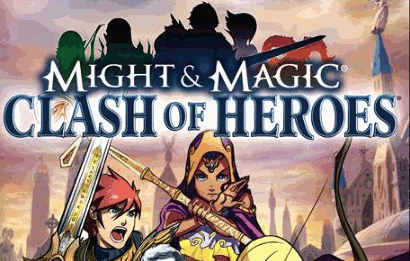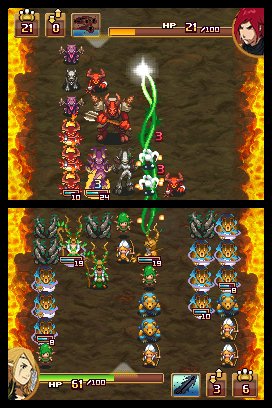Don’t let the faux-anime art style or puzzle-based gameplay put you off – Might & Magic: Clash of Heroes is a great handheld role-playing game that should be in every RPG collection.
Faithful readers may be scratching their heads right now, given my attack of this game in my October 11, 2010 post titled Ultima, The Bard’s Tale, and Might & Magic – Where are the Real Sequels, in which I summarized it as “a shallow, JRPG-style story with zero original Might & Magic lore, and a match-three-colors puzzle game” and compared its visuals to Space Invaders. (In my defense, I also called it “incredibly fun and addictive.”) Readers may also be wondering why I am reviewing a game from 2009 on the eve of 2011.
The answer to the second question is that it took me a long time to finish this game. Since picking it up over a year ago, Clash of Heroes has entertained me through jury duty, several train rides and doctors’ waiting rooms, and visits to my in-laws, and recently has been the game I chose to play instead of PC and console games while at home. As my appreciation for the game grew, I decided to post a review despite the game’s age. Regarding the first question – regardless of its quality, I don’t consider this game to be a true Might & Magic RPG. Therefore, I stand behind most of my original statements.
Game: Might & Magic: Clash of Heroes
Genre: Puzzle RPG
Version reviewed: Nintendo DS
Also available for: XBox Live Arcade (coming soon), PlayStation Network (coming soon)
Time to complete: About 40 hours
Save system: Save anywhere except in combat
Might & Magic: Clash of Heroes, developed by Capy and published by Ubisoft for the Nintendo DS, is not a graphical powerhouse. The game is sprite-based and two-dimensional, bringing to mind JRPGs from the Super Nintendo era. Exploration takes place from a top-down perspective, and the anime influence in the character art adds to this JRPG flavor. Make no mistake, however – this game is western. The story is straight Tolkien high fantasy. The 2D backgrounds are frequently beautiful and often bring to mind the backgrounds in BioWare’s Infinity Engine games. The characters are all likeable (with no androgynous whiners or chocobos in sight), the dialogue is well written, and the narrative features surprising plot twists, betrayals, and reversals. The tone of the game moves effortlessly between darkness and humor. You won’t want to skip the cut-scenes in this one – I have no hesitation calling Clash of Heroes the best-written puzzle RPG of all time.
 But excellent writing and artwork will only get you so far – this is a game, after all. I won’t pretend that Clash of Heroes is a strategy RPG. That said, I can’t overemphasize what a difference is made by the design decision to make the “pieces” in the puzzle battles resemble soldiers and monsters rather than jewels. While it is true that the game would play identically if the puzzle battles involved gems or fuzzballs (the game is, at heart, a “match-three” puzzle game similar to Bejeweled 3
But excellent writing and artwork will only get you so far – this is a game, after all. I won’t pretend that Clash of Heroes is a strategy RPG. That said, I can’t overemphasize what a difference is made by the design decision to make the “pieces” in the puzzle battles resemble soldiers and monsters rather than jewels. While it is true that the game would play identically if the puzzle battles involved gems or fuzzballs (the game is, at heart, a “match-three” puzzle game similar to Bejeweled 3 and Puzzle Quest 2
), the game makes you feel like you are manipulating warriors in a fantasy army. For me, the battles felt more like a turn-based combat system than a puzzle game. All computer RPG combat systems are abstract to some extent – is pressing A to attack in The Bard’s Tale, or picking off enemies in the VATS system in Fallout: New Vegas
, really that much less arbitrary than “powering up” a titan by lining up four similarly colored gremlins behind him? The fact that you can level up your little warriors adds to the feeling that they are more than puzzle game pieces.
The game isn’t perfect. One problem I encountered is that you cannot gauge an enemy’s level before you engage the enemy in combat. That demon blocking your path to a treasure chest could be a pushover level 3 or an unstoppable level 8, and once combat commences, there is no option to retreat. This issue is somewhat mitigated by the fact that you can save your progress at any time, so if you save before each battle, you can reload your game after the level 8 demon wipes the floor with your level 4 hero. Still, this issue could have been easily avoided had the designers given the player some indication of an enemy’s strength prior to combat. Also, as mentioned above, the game is extremely linear. You literally move your character along a dotted line, with few opportunities to explore locations off of the main path. The only side quests are bounties and special puzzles, which really just amount to more of the same.
Clash of Heroes includes a multiplayer mode. I was not able to test this mode, as, sadly, I am the only person my age who I know who even owns a Nintendo DS, much less this game. A high definition version of Clash of Heroes is supposedly coming soon to XBox Live Arcade and PlayStation Network – maybe I’ll have better luck finding a human adversary using one of those versions. Regardless of my feelings about Ubisoft’s decision to market Clash of Heroes under the Might & Magic brand, I recommend this game to any RPG fan with a DS – give Clash of Heroes a chance, and it will win you over.
The Final Dungeon Score: 8 out of 10


Nice review, this looks like a great RPG game. 😀